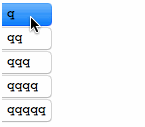SetterBar behavior
To keep button size, one option would be to add StringPadRight
SetterBar[1, StringPadRight @ ( StringRepeat["q", #] & /@ Range@5 ),
Appearance -> {"Vertical", "Button"}]

To diminish margins one possible way is to add "AbuttingLeft", i.e.
SetterBar[1, StringPadRight @ ( StringRepeat["q", #] & /@ Range@5 ),
Appearance -> {"Vertical", "AbuttingLeft"}]

As a trade-off, one more documented option is to use Appearance->"Palette".

Also notice that at my Mac OS with V10.3 "Horizontal" appearance behaves in the same way (with small move of the right side of double-clicked buttons).

For Manipulate it is also possible to use ImageSize and Alignment via Row like so:
Manipulate[s,
{{s, 1}, (# ->
Row[{#}, ImageSize -> 39, Alignment -> Center]) & /@
(StringRepeat["q", #] & /@ Range@5), SetterBar, Appearance -> "Vertical"},
ControlPlacement -> Left]
@MichaelE2's warning concerning size parameters applies here as well.
I usually use Pane to solve such alignment problems. String padding in a variable-width font does not produce reliable results, and Pane can be used to get around that. (Fortunately or unfortunately, a vertical SetterBar automatically pads out the buttons to be the same sizes, and I cannot check this on Windows.)
One of the issues is to determine the dimensions to use for Pane. In particular, the width depends on the style in which the SetterBar is ultimately displayed. When the style is unknown, it can be a challenge to get it right. Usually, I don't worry if the dimensions are little too large, and estimate by trial and error. However, sometimes one wants to get it exactly right, or at least exactly the same as something else. For that one can apply Rasterize to the string in the display style.
strings = StringRepeat["q", #] & /@ Range@5;
width = First@Rasterize[#, "BoundingBox"] & /@ strings // Max
(* 39 *)
SetterBar[1, Pane[#, width, Alignment -> Center] & /@ strings, Appearance -> {"Vertical"}]

For another style, do this:
style = "Label";
width = First@Rasterize[Style[#, style], "BoundingBox"] & /@ styledstrings // Max
(* 28 *)
SetterBar[1, Pane[#, width, Alignment -> Center] & /@ strings, Appearance -> {"Vertical"},
BaseStyle -> style]

For a Manipulate setter bar, use the "ManipulateLabel" style:
style = "ManipulateLabel";
width = First@Rasterize[Style[#, style], "BoundingBox"] & /@ styledstrings // Max
(* 27 *)
Manipulate[
s,
{{s, "q"}, # -> Pane[#, width, Alignment -> Center] & /@ strings,
SetterBar, Appearance -> {"Vertical"}, ControlPlacement -> Left}
]

One can compare the width with the default Manipulate, or with other values for width, with
Grid[List /@ {man1, man2,...}, Spacings -> 0,
Dividers -> {{1 -> Thin, 2 -> Thin}, None}]
Below are the widths in the "ManipulateLabel" style of the strings padded with spaces. They vary considerably.
First@Rasterize[Style[#, style], "BoundingBox"] & /@
StringPadRight@(StringRepeat["q", #] & /@ Range@5)
(* {15, 19, 21, 25, 27} *)
For a fixed-width font, there is no such problem.
First@Rasterize[#, "BoundingBox"] & /@
StringPadRight@(StringRepeat["q", #] & /@ Range@5)
(* {39, 39, 39, 39, 39} *)